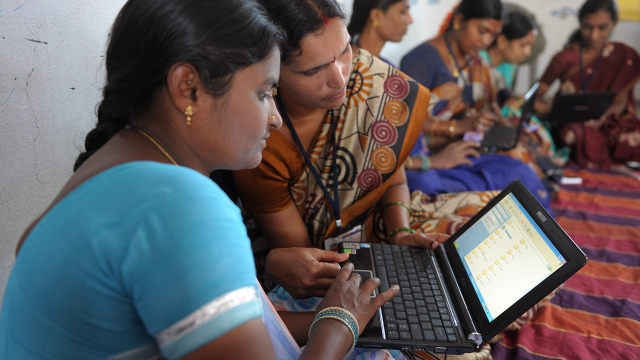
While internet use is nearly ubiquitous in many countries, not everyone is online. Divides still exist on technology usage between people in some advanced economies and those in some emerging economies, according to Pew Research Center data from 27 countries in 2022 and 2023.
Smartphone ownership and social media use also vary around the world. While most adults in the countries surveyed own smartphones and use social media, there are still pockets where many do not.
In addition, there are divides within countries on internet use, smartphone ownership and social media use based on demographic factors such as age, education and income. Almost universally, younger people and those with more education and income are more likely to be online, own a smartphone and use social media.
Related: Americans’ Use of Mobile Technology and Home Broadband
This analysis explores internet, social media and mobile phone use in 27 countries. It uses data from multiple Pew Research Center surveys:
- 2022 Global Attitudes Survey of 20,944 respondents across 18 advanced economies from Feb. 14 to June 3, 2022
- 2023 Global Attitudes Survey of 10,235 respondents across eight emerging and developing economies (Argentina, Brazil, India, Indonesia, Kenya, Mexico, Nigeria, South Africa) from Feb. 25 to May 22, 2023
- 2023 National Public Opinion Reference Survey (NPORS) of 5,733 U.S. respondents from May 19 to Sept. 5, 2023
The data was collected using various methods, including online, face-to-face and telephone interviews.
Data from Australia is not included in analyses of internet use or phone ownership.
NPORS asked Americans about specific websites or apps used, but the data is not comparable to the question on social media in other countries. For more on technology use in the United States, including specific social media site usage, read “Americans’ Use of Mobile Technology and Home Broadband” and “Q&A: How – and why – we’re changing the way we study tech adoption.”
Technology use can influence how surveys are conducted. For example, our surveys in Malaysia, Singapore and South Korea are only conducted on mobile phones because the prevalence of mobile phone ownership is so high. A 2023 study by the Korea Information Society Development Institute found that 98.3% of all people in Korea, not just adults, own a mobile phone.
In addition, people who take our survey over the phone may be more likely to use technology than those who take the survey in person. In 2019, we conducted simultaneous telephone and in-person surveys in Italy. Both samples were representative of the Italian population with respect to age, gender, education and region. Respondents who took part in the telephone survey had somewhat higher rates of internet use, smartphone ownership and social media use. We moved from in-person interviews to telephone interviews in Italy in 2020 and Greece in 2021, and we do not make direct comparisons to survey results prior to the mode change.
Respondents in each country were provided with a list of smartphone and social media types; refer to this country-specific table for more information.
To compare educational groups across countries, we standardize education levels based on the UN’s International Standard Classification of Education (ISCED).
- In India, Indonesia, Kenya, Nigeria, South Africa and Brazil, the lower education category is below secondary education and the higher category is secondary or above.
- The lower education category is secondary education or below and the higher category is postsecondary or above in Belgium, Canada, France, Germany, Greece, Hungary, Italy, Netherlands, Poland, Spain, Sweden, the UK, Australia, Japan, Malaysia, Singapore, South Korea, Israel, Argentina and Mexico.
- The lower education category is some college or below and the higher category is a college degree or more in the U.S.
Here are the questions used for this report, along with responses, and its methodology. U.S. smartphone and internet data was drawn from a separate list of questions.
This is the first post in a series about internet use worldwide. The next post will focus on social media’s perceived influence on democracy. Data for this series was collected over two years using various methods, including online, face-to-face and telephone interviews.
Here are eight charts about technology use around the world.
A majority of adults in all countries surveyed use the internet. Internet users are defined as people who say they use the internet at least occasionally or have access to the internet via a smartphone.
In most countries surveyed, around nine-in-ten or more adults are online. At the upper bound, 99% of South Koreans are online.
Comparatively fewer adults are online in India (56%), Nigeria (57%) and Kenya (66%). Still, internet use in these countries continues to grow as economic outcomes improve and technology becomes more widespread.
Within countries, however, internet use remains highly dependent on demographic factors such as age, education and income.
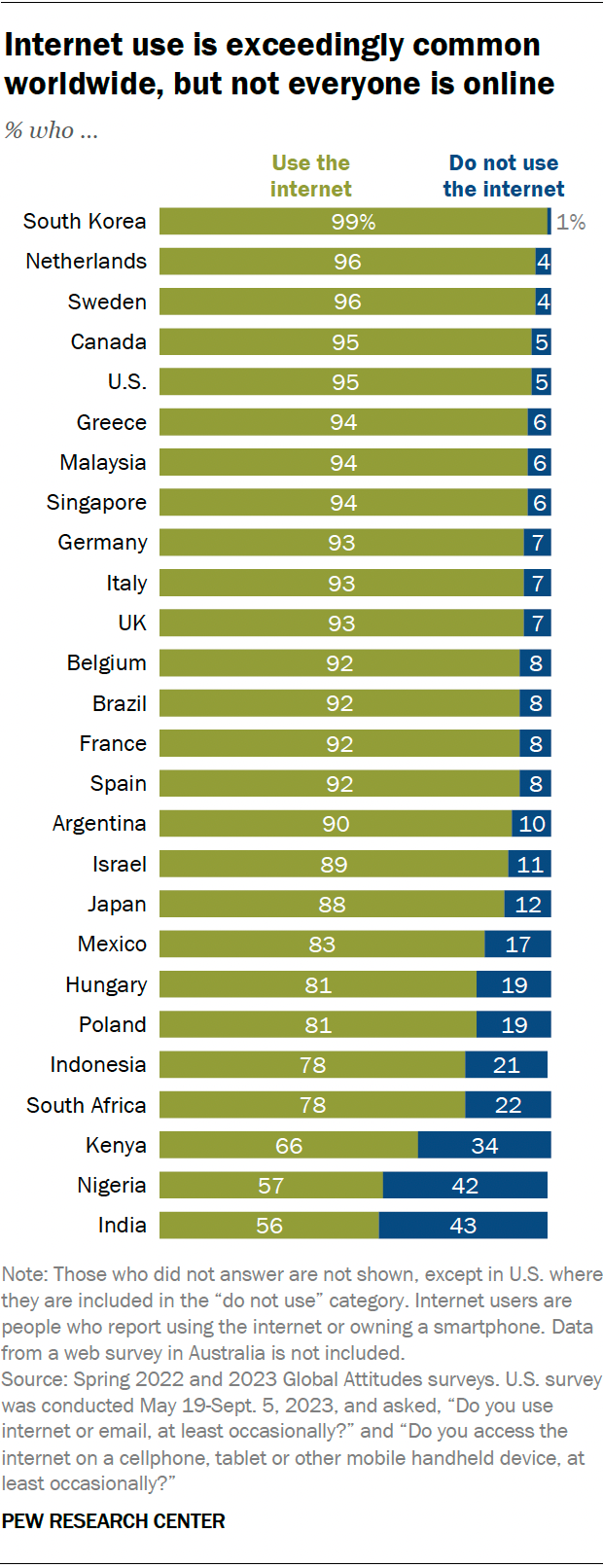
In every country surveyed, adults ages 18 to 39 are significantly more likely than those 40 and older to use the internet. These gaps are especially large in several of the middle-income countries surveyed in 2023.
For example, 73% of adults in India who are younger than 40 say they use the internet, compared with 36% of Indians 40 and older. Similar gaps exist in Hungary, Indonesia, Mexico and Poland.
Differences by age in advanced economies are relatively small. In just over half of these countries, internet use among 18- to 39-year-olds is universal, at 100%.
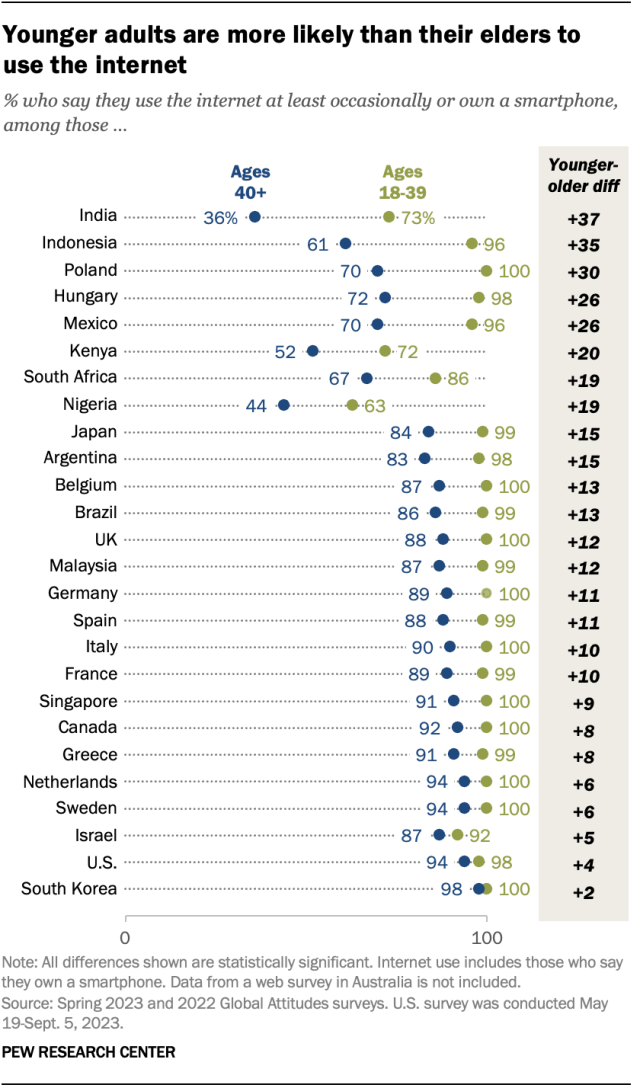
In all countries surveyed, adults with more education are more likely than those with less to use the internet. As with age, the education gap on internet use is most pronounced among people in emerging economies, such as India and Nigeria. In these countries, those with more education are about twice as likely as those with less education to use the internet.
Large gaps by educational attainment also exist in Indonesia, Kenya, Poland and South Africa. (Because education systems differ by country, the levels of education for “more education” and “less education” also vary. Read the “How we did this” section for more information.)
Similarly, adults with higher incomes are much more likely than those with lower incomes to use the internet.
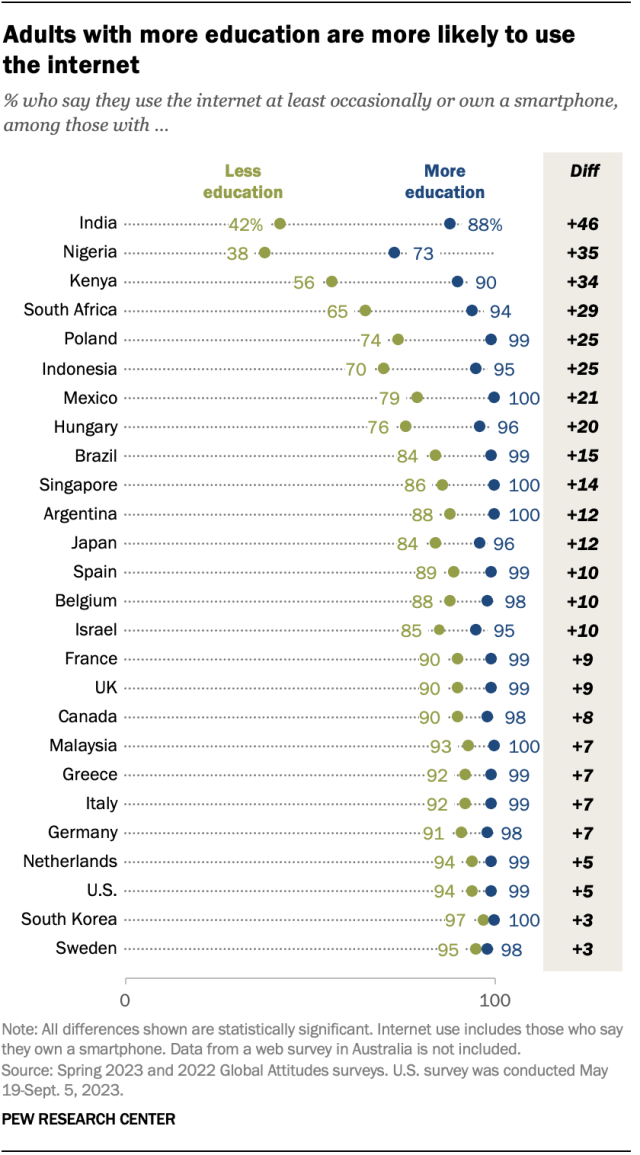
Majorities of adults in nearly every country surveyed say they own a smartphone. Rates of smartphone ownership are highest in South Korea, where 98% report owning a smartphone, and lowest in India and Nigeria, where fewer than 50% do. (Refer to the appendix for types of smartphones given as examples in each country.)
Around three-quarters or more of adults in advanced economies in North America, Europe and Asia say they have smartphones.
However, two-in-ten or more in India, Kenya and South Africa say they own a mobile phone that is not a smartphone. In Nigeria, 42% say this.
And in India, three-in-ten say they do not own a mobile phone at all – the highest share of any country surveyed.
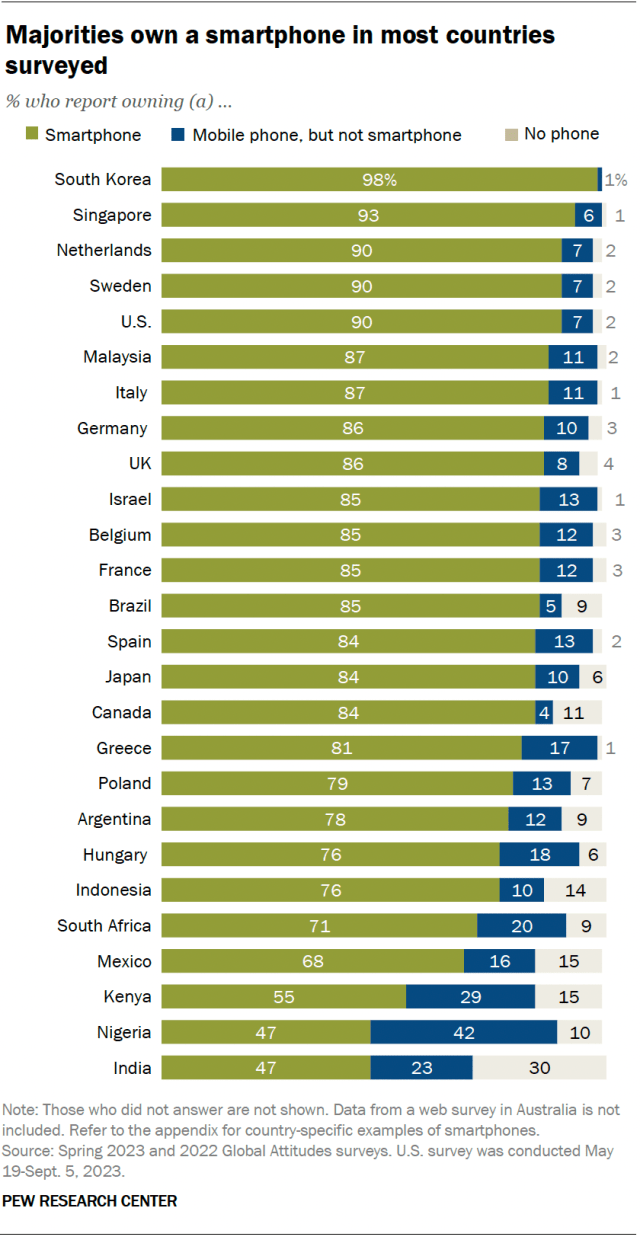
Smartphone ownership tends to be higher in countries with higher per-capita gross domestic product. Similar patterns also appear within countries: In nearly every country surveyed, people with incomes above the national median are more likely than those with lower incomes to report owning a smartphone.
These differences are largest in Hungary, Israel and Poland, where people with higher incomes are around 30 percentage points more likely than those with lower incomes to have a smartphone.
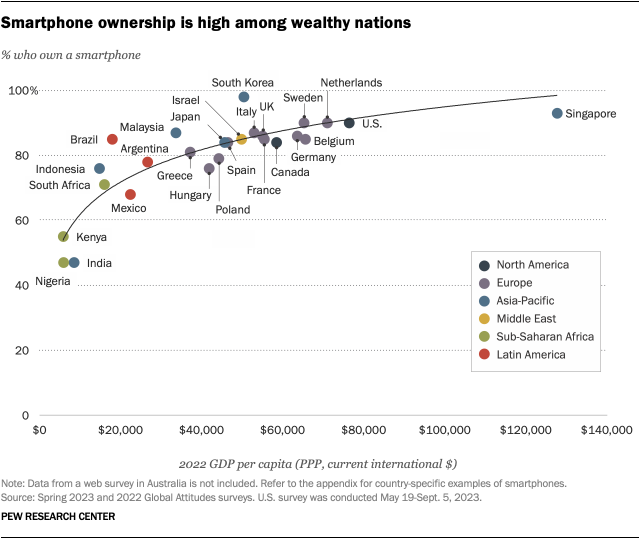
Adults with more education and older adults are more likely than their counterparts to own a smartphone in every country surveyed. In India, around three-quarters of those with at least a secondary school education own a smartphone, compared with around one-third of people with less education.
Large gaps also exist in Mexico (36 percentage points), Kenya (34 points), South Africa (32 points) and Nigeria (30 points).
In addition, adults ages 18 to 39 are more likely than their elders to own smartphones in nearly every country surveyed. For example, 98% of younger adults in Hungary say they own a smartphone, compared with 65% of adults 40 and older.

Roughly half or more of adults in 26 countries say they use social media sites. Social media use is most common in Argentina, Brazil and Malaysia, where over eight-in-ten report using social media sites such as Facebook, Twitter (now known as X) and Instagram. (Refer to the appendix for the list of sites people in each country were given as examples of social media.)
But social media use is widespread across most surveyed countries. Majorities in all but two countries report using social media.
In Europe, Germany (51%) is the only country where fewer than six-in-ten adults say they use social media. And in the Asia-Pacific region, India (47%) is the only country where fewer than seven-in-ten say this.

Adults under age 40 are more likely than their elders to use social media. In every country surveyed, the difference between younger and older adults is greater than 10 percentage points.
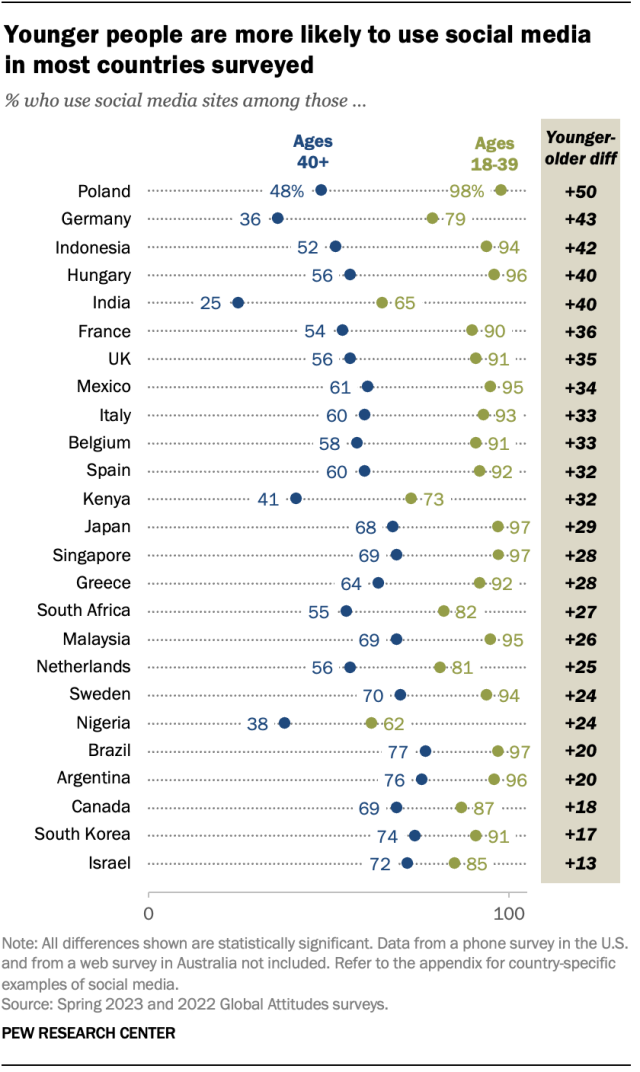
The gap is biggest in Poland, where 98% of adults under age 40 use social media sites. Only about half (48%) of their older counterparts say the same. In Germany, Hungary, India and Indonesia, there are also differences of 40 points or more.
The gap is smallest in Israel, where 72% of those 40 and older report using social media, compared with 85% of younger adults.
A 2022 Center report found that the age gap in social media use has narrowed over time across 19 advanced economies. That is because older adults’ rate of using social media has increased more quickly than that of younger adults in a number of countries.
In some countries, those on the political left are also more likely than those on the right to use social media. For example, eight-in-ten Hungarians who place themselves on the ideological left report using social media sites, while about six-in-ten of those on the right say the same.
Note: Here are the questions used for this report, along with responses, and its methodology.
CORRECTION (Feb. 7, 2024): Previous versions of the first six charts in this post misstated the survey mode used in the U.S. survey.





